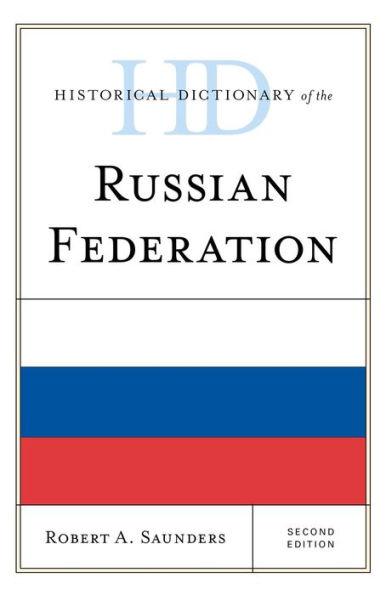The scope of this entry in the publisher’s Historical Dictionaries of Europe series is defined as “pivotal movements, events, and persons in the late Soviet Union (1985–1991) and contemporary Russia (1991–present)” as well as geography, culture, politics, and more. It is broadly inclusive, with Alcoholism, Chernobyl disaster, Crimea, Dacha, Education, Globalization, Immigration, Islam, Oblast (an administrative division), and Sberbank (the oldest and largest credit institution in Russia) among the more than 600 entries, along with Obama, Barack Hussein and Putin, Vladimir Vladimirovich. Entries are preceded by a chronology organized by eras, from the Soviet period (1917–1985) to the “Medvyedev Era.” Appendixes list heads of state as well as prime ministers. So thorough and scholarly are these authors that their bibliography is preceded by a contents page and an introduction. It also includes a categorized list of Internet resources. Their volume is recommended for academic and large public libraries.
This is a thorough reference work covering the first two decades of post-Communist Russia…. The dictionary is very well done…. There is value-added provided by this volume…. Provides some inherent value despite technological change.
As with other Scarecrow Dictionaries, Drs Saunders and Strukov appear to have written this entire work themselves rather than parcelling it out among a team of colleagues. They are both career specialists in modern Russia – Strukov at Leeds University in the UK and Saunders at the State University of New York, SUNY for short. Whilst there is a mass of work on this recent patch of Russian history, I doubt whether much of it equals this book for compendiousness. The Historical Dictionary of the Russian Federation fills a gap in the truest sense of the word.
As with other Scarecrow Dictionaries, Drs Saunders and Strukov appear to have written this entire work themselves rather than parcelling it out among a team of colleagues. They are both career specialists in modern Russia – Strukov at Leeds University in the UK and Saunders at the State University of New York, SUNY for short. Whilst there is a mass of work on this recent patch of Russian history, I doubt whether much of it equals this book for compendiousness. The Historical Dictionary of the Russian Federation fills a gap in the truest sense of the word.
The scope of this entry in the publisher’s Historical Dictionaries of Europe series is defined as “pivotal movements, events, and persons in the late Soviet Union (1985–1991) and contemporary Russia (1991–present)” as well as geography, culture, politics, and more. It is broadly inclusive, with Alcoholism, Chernobyl disaster, Crimea, Dacha, Education, Globalization, Immigration, Islam, Oblast (an administrative division), and Sberbank (the oldest and largest credit institution in Russia) among the more than 600 entries, along with Obama, Barack Hussein and Putin, Vladimir Vladimirovich. Entries are preceded by a chronology organized by eras, from the Soviet period (1917–1985) to the “Medvyedev Era.” Appendixes list heads of state as well as prime ministers. So thorough and scholarly are these authors that their bibliography is preceded by a contents page and an introduction. It also includes a categorized list of Internet resources. Their volume is recommended for academic and large public libraries.
This comprehensive reference work provides detailed information on significant historical and political events, important Communist leaders, political parties, ethnic groups, religions, economic issues, key state bodies, and different aspects of Russia's relations with its former satellite states....The thorough entries include important historical and political incidents, people, places, and organizations. Entries are arranged in alphabetical order and cross-referenced as appropriate. Two appendixes list the Russian Federation heads of state and prime ministers. A detailed bibliography covers all aspects of Russian history, including general works, historical and political events, social structures, and Internet resources. Summing Up: Highly recommended.
This comprehensive reference work provides detailed information on significant historical and political events, important Communist leaders, political parties, ethnic groups, religions, economic issues, key state bodies, and different aspects of Russia's relations with its former satellite states....The thorough entries include important historical and political incidents, people, places, and organizations. Entries are arranged in alphabetical order and cross-referenced as appropriate. Two appendixes list the Russian Federation heads of state and prime ministers. A detailed bibliography covers all aspects of Russian history, including general works, historical and political events, social structures, and Internet resources. Summing Up: Highly recommended.
The scope of this entry in the publisher's Historical Dictionaries of Europe series is defined as "pivotal movements, events, and persons in the late Soviet Union (1985-1991) and contemporary Russia (1991-present)" as well as geography, culture, politics, and more. It is broadly inclusive, with Alcoholism, Chernobyl disaster, Crimea, Dacha, Education, Globalization, Immigration, Islam, Oblast (an administrative division), and Sberbank (the oldest and largest credit institution in Russia) among the more than 600 entries, along with Obama, Barack Hussein and Putin, Vladimir Vladimirovich. Entries are preceded by a chronology organized by eras, from the Soviet period (1917-1985) to the "Medvyedev Era." Appendixes list heads of state as well as prime ministers. So thorough and scholarly are these authors that their bibliography is preceded by a contents page and an introduction. It also includes a categorized list of Internet resources. Their volume is recommended for academic and large public libraries.--Booklist
This is a thorough reference work covering the first two decades of post-Communist Russia.... The dictionary is very well done.... There is value-added provided by this volume.... Provides some inherent value despite technological change.--The Russian Review
This comprehensive reference work provides detailed information on significant historical and political events, important Communist leaders, political parties, ethnic groups, religions, economic issues, key state bodies, and different aspects of Russia's relations with its former satellite states....The thorough entries include important historical and political incidents, people, places, and organizations. Entries are arranged in alphabetical order and cross-referenced as appropriate. Two appendixes list the Russian Federation heads of state and prime ministers. A detailed bibliography covers all aspects of Russian history, including general works, historical and political events, social structures, and Internet resources. Summing Up: Highly recommended.--CHOICE



